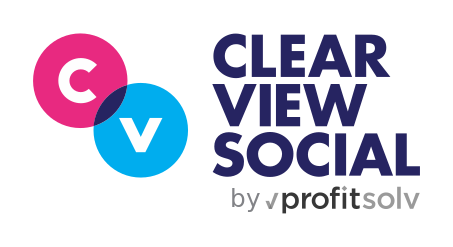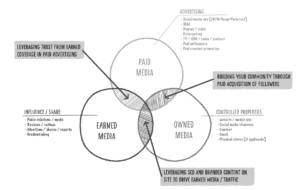Building brand awareness and boosting engagement with your followers is becoming increasingly difficult in the age of constant digital content. Brands are competing for attention amid a saturated market of videos, social media posts, digital ads, and content from users themselves. If your brand is struggling to stand out among the noise, you aren’t alone.
Many marketing teams are returning to the basics to find ways to reach customers. One simple framework categorizes messaging and context into three buckets: paid, owned, and earned media.
Within this framework, earned media remains one of the most impactful tools in your marketing arsenal. In this guide, we’ll share some earned media examples as well as some tips for making earned media work for your brand using employee advocacy.
But first, let’s take a closer look at this concept.
What is earned media?
Earned media is any content that mentions your company online—but it doesn’t come from you. This content can include mentions from fans, influencers, and customers that share stories, posts, and videos about your products or services on their own platforms.
Earned media examples include:
- Social media posts recommending your product, business, or service
- Shares, retweets, or comments on your social media comment
- Reviews on sites such as Google, Yelp, or Amazon
- Influencer marketing
- Unsponsored blogs promoting your products or services
- Radio and media coverage discussing your product or service
Earned media (also known as word-of-mouth marketing) builds for your brand. Potential customers see that your brand is legitimate and trusted, and conclude that they should also employ your services or buy your products.
How much is earned media worth?
Tracking earned media value (EMV) is a little more difficult than measuring the ROI of a paid marketing campaign. Dozens of studies have shown that word-of-mouth marketing is one of the best ways to promote your brand. Consider these stats:
- Word-of-mouth drives $6 trillion in annual global spending and is responsible for 13% of all sales. (Semrush)
- 74% of consumers identify word-of-mouth as a key influence in purchasing decisions. (Ogilvy Cannes)
- Influencer marketing carries a ROI of $6.50 for every dollar spent. (WebFX)
Data points like these make earned media a more effective tool for marketers than paid and owned media. And, while measuring the impact of earned media can be tricky, we’ll show you how tools like Clearview Social can help. But first, let’s cover how earned and owned media can work together to supercharge your brand communications.
Owned media vs. earned media
In comparison to earned media, owned media is any marketing content that your brand creates, owns, and publishes. Owned media examples include:
- Web and blog content
- Social media posts
- YouTube videos
- Email campaigns
- Direct mail
Owned media is incredibly effective in your content strategy. Since it is typically content that you have control over—meaning you choose where and when it’s published—you can always create more of it with the goal of reaching your audience in an organic way.
Owned media is often a good space for amplifiying your earned media. When you see a piece of user-generated content (earned media), consider posting it on your owned channels with proper attribution. This social proof should be shared far and wide! And, that’s not the only way to combine owned and earned media in your marketing strategy.
How earned and owned media fit into your marketing strategy
Leveraging different types of content across different platforms is key to engaging audiences and building brand familiarity. A multi-channel strategy amplifies your brand. When your audience sees consistent, varied content posted across social media channels, they’re much more likely to remember you—and become repeat customers.
Using each type of media alone has its benefits. But, combining them into a holistic marketing strategy is where you’ll see maximum results. Start by making earned media the cornerstone of your content strategy, and use paid and owned media to spread the message.
Earned Media Examples
Here are a few earned media strategy examples to show you how this could work.
AXE DogeCan
Body spray brand AXE capitalized on one of the weirder parts of the internet, Dogecoin, a cryptocurrency inspired by a meme of a Shiba Inu. In honor of Doge Day, a made-up internet holiday, the brand sent a tweet promising to launch a “Dogecoin scent” if the value of a Dogecoin (the cryptocurrency) reached $1. The tweet went viral, and the brand delivered: AXE DogeCan. The scent sold out in less than a minute—again, going viral. The campaign earned 2 billion impressions at $0 of media spend, garnering attention from tons of media outlets and news channels.
Ocean Spray TikTok
In 2021, a TikTok of Nathan Apodaca skateboarding to the tune of Fleetwood Mac’s “Dreams” went viral. In the video, Apodaca is seen coasting down the highway drinking Ocean Spray Cran-Raspberry juice straight from the bottle. His truck had broken down earlier and this was just a morning commute for Apodaca. More than 27 million views later, Ocean Spray decided to capitalize on the earned media the video was offering. The juice brand gifted Apodaca a new truck and created its own viral video in which Ocean Spray’s CEO paid homage to Apodaca’s original TikTok.
Redbull on Twitter
Earned media doesn’t have to entail a new product launch or viral TikTok video. It can be as simple as Redbull’s infrequent re-tweets of content from other users.
today’s PSA 🗣 https://t.co/iklo4Hs7kv
— Red Bull (@redbull) September 29, 2021
Retweeting or re-posting reviews from your fans is an easy way to make use of earned media. Here are a few other ways to make the most of earned media (and convert more customers along the way):
- Use your website or social media profiles to share reviews, posts, and feedback from customers.
- Encourage satisfied customers to leave reviews by sending them templates or prewritten language.
- Offer incentives or promotional gifts for followers or employees who like, retweet, or share a piece of content.
- Create engaging and authentic content that earns shares, comments, and retweets.
- Create platforms online in which customers get the opportunity to review your products or services, leave comments, or engage in forum discussions. This could include Twitter threads, LinkedIn discussions, Facebook groups, or YouTube comments. (Bonus points if you respond to the comments or engage in discussions!)
As you can see from these earned media examples, this content becomes the key ingredient in an owned media and paid media campaign. Earned media gives you something to talk about: it gives paid media outlets plenty of fuel to talk about your brand, as well as credibility on your own channels.
So, where do you find earned media to use in your campaigns? An employee advocacy program is a good place to start.
Employee advocacy for earned media
Employee advocacy encourages employees to share their experience at your company and dramatically increase your brand’s visibility.
[Read more: What is Employee Advocacy: Definition, Examples, and Strategies for 2023]
Employee advocacy allows brands to leverage an existing community of advocates —your employees—to turn it into earned media that extends all the way past your employees’ networks.
Recent LinkedIn statistics reveal that a typical user has 930 connections, while company pages often have 1,000. Now, imagine you have 50 employees and 30 of them have LinkedIn accounts. Even if only half of them share content about your brand. This would translate to almost 14,000 views. We call this phenomenon the “spider web effect.” The more people that share your content, the bigger your reach becomes.
That results in far more impressions and engagements than can be accomplished with organic social media alone. And, tools like Clearview Social make it easy to generate earned media from your employee advocacy program.
For almost ten years now, the team at Clearview Social has been helping companies of all sizes and industries boost their online presence through employee advocacy efforts—the easiest way to immediately boost your earned media value.
Our employee advocacy offers accessible sharing features to maximize your online presence, including:
- One-click email sharing so your employees can share company social content to their personal pages in seconds.
- Article queue builders to easily plan out posts online.
- PeakTime™ AI posts for you when the majority of your target audience is online.
Leverage your owned content into earned media and boost your social reach by requesting a free demo with Clearview Social today.

